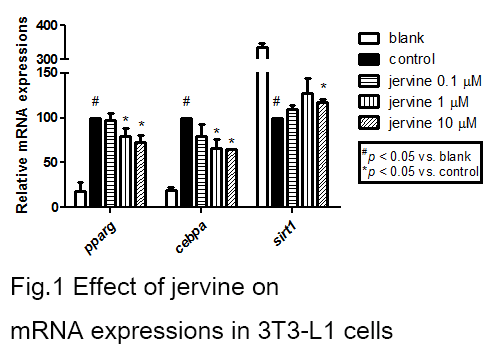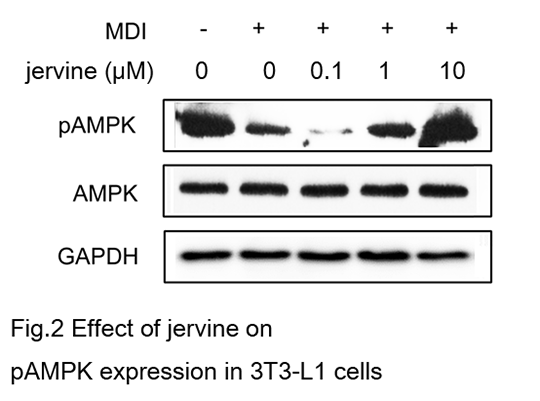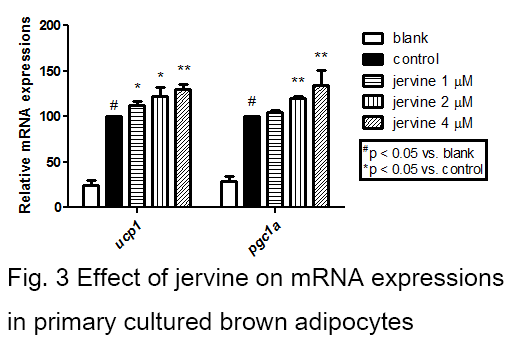Effects of Jervine, a Steroidal Alkaloid, in 3T3-L1 adipocytes and Primary Cultured Brown Adipocytes Obesity became a major health threat in developed countries recently. However, current medications for obesity are limited because of their adverse effects. Thus, interest in natural products for the treatment of obesity is rapidly growing. The authors’ previous work has shown the anti-obese effects of Veratrum nigrum (1). However, the effect of jervine, a component of Veratrum nigrum, on obesity has not been reported to date. Jervine ((3β,23β)-17,23-Epoxy-3-hydroxyveratraman-11-one) is a steroidal alkaloid which is derived from the Veratrum plant genus. In this study, we have shown the effects of jervine on obesity in vitro using 3T3-L1 adipocytes. 3T3-L1 cells were grown in DMEM containing 10% FBS at 37 °C in a 5% CO2 atmosphere in 6-well culture dishes. Two days after full confluence, cells were differentiated by incubation during two days in DMEM containing 25 mM glucose, 0.5 mM 3-isobutyl-1-methylxanthine, 1 μM dexametasone, 1 μg/ml insulin and 10% FBS. After 48 h, the cells were with DMEM containing 10% FBS, 1 μg /ml insulin and jervine (0.1, 1, 10 μM) were added along with the medium. After another 48h, the medium consisted of DMEM with 10% FBS and 1 μg /ml insulin and was changed every second day. The lipid accumulation was assessed by the Oil red O method. The mRNA expressions of PPAR γ, C/EBP α, and SIRT1 were evaluated by real-time RT-PCR, and the p-AMPKα expression was assessed using the Western blot method. Data are given as mean±SEM, and statistical evaluation of the results was performed by independent t-test with the significancy of p < 0.05. The administration of jervine (10 μM) down-regulated lipid accumulation by nearly 22% when compared to fully differentiated 3T3-L1 adipocytes. Also, as in Fig. 1, jervine treatment decreased the two key adipogenesis factors PPAR γ and C/EBP α (2) significantly, and successfully increased SIRT1, which is known to promote lipolysis and loss of fat mass (3). Furthermore, jervine significantly up-regulated the phosphorylation of AMPKα when compared to differentiated adipocytes (Fig. 2). In addition, mRNA expressions of UCP1 and PGC1 α were up-regulated by jervine in primary cultured brown adipocytes (Fig. 3).
In this study, jervine suppressed PPAR γ and C/EBP α, up-regulated SIRT1 and the phosphorylation of AMPKα in 3T3-L1 cells suggesting anti-obese effects of jervine. Furthermore, the up-regulation of PGC1 α and UCP1 in brown adipocytes may imply the thermogenic potential of jervine, leading it to a new therapeutic agent of obesity. (1) Park J et al. (2013). Evid Based Complement Alternat Med 2013: 732126. (2) Lee H et al. (2011). Life sciences 89: 388-394. (3) Picard F et al. (2004). Nature 429: 771-776.
|




